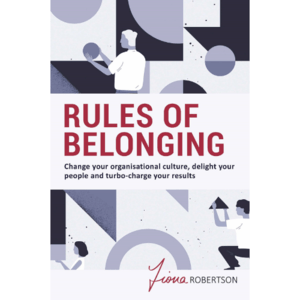Trending Blogs


THE RULES OF BELONGING

Project Resource Partners enjoyed having the very engaging Fiona Robertson present our timely workshop; The Rules of Belonging: Creating an Organisational Culture to Drive Your Results. Given the current circumstances we face in Melbourne, creating that sense of belonging is something that is more important than it is normal.
The topic of belonging could have been an all day workshop, rather than the 45 minutes we had, but Fiona was able to give us a real feeling on why belonging is so important, how to use belonging to create a culture that will drive results, and how it is that culture and strategy intersect. It is fair to say that I had a lot of content to come up with my top 10 takeaways!
What this workshop showed was how important the feeling of belonging is to us as human beings, how it creates and provides us with that feeling of safety and how is the rules of belonging are so integral to culture.
If you do want to know more about this , Fiona’s book 'Rules of Belonging - Change your organisational culture, delight your people and turbo-charge your results' would be a great place to start. The first chapter can be found by clicking the below button:
In the meantime, here are my top 10 takeaways from Fiona’s workshop, in the knowledge that, to paraphrase our presenter, culture change may not be easy, but it is simple:
- There have been two types of evolution; biological and cultural. The former is glacially slow, whilst the latter grows exponentially, creating fast moving change in society, and as an extension of that organisations
- Our brain does not distinguish between physical pain and social pain, and this is shown in the research of Matt Lieberman, a renowned neuroscientist
- Belonging trumps Maslow’s Hierarchy of Needs, because whilst we need shelter, food, and water, it is belonging that gives us access to them
- The brain, a Threat Detection Pattern Recognition Machine, is wired to keep us safe, and as such, it senses if we don’t belong - as that puts our safety at risk - because as humans we are the ultimate social species
- With belonging being such an important driver, it means we look to behave our way to Belonging. We watch, to see what to do. We evaluate, to see how others react, to know who the leaders are. We experiment, to see if our behaviour allows us to belong. If it does then embrace the behaviour, and finally we enforce the behaviour. We do not want it to change because it keeps us safe.
- This is what creates the culture of our organisations, it is the Rules of Belonging
- More than just how we behave though, it is how we interpret behaviours that drive our company’s culture. The same behaviour in two different organisations, even two teams, could be interpreted in a completely different way. In one it creates or reinforces belonging and in another it could lose belonging
- This interpretation then influences engagement and culture, which are not one in the same thing. Engagement is how we experience the system, where as the culture, is the underlying system. Changing engagement, does not change the culture, as we do not look at interpreting the behaviours therefore we are not changing the system
- To change culture, we have to change the Rules of Belonging. We must ask; what earns belonging, and are they the behaviours that we want to see more of, to achieve the belonging to the culture we want to create or reinforce
- Is that culture that we want, created by those Rules of Belonging, the culture we need to execute our strategy? Culture does not eat strategy, it sits at the table with it, it needs to align to it. That means it is not always easy to align, as we may need to change the Rules of Belonging, and that may challenge the safety of our people. It is not that humans are bad at change, it is just we’re good at it if it serves our sense of belonging.
That is why, as Fiona says, culture change may not be easy, but it is simple.


